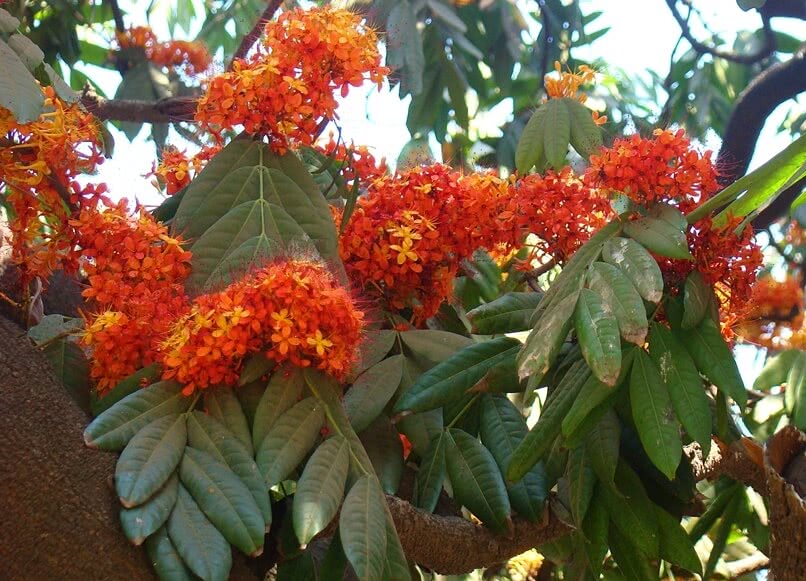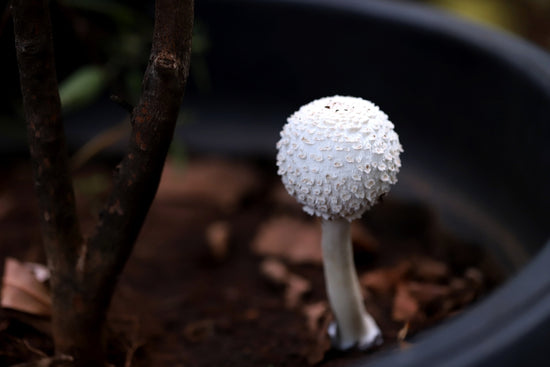About Sita Ashoka tree:
Ashok is one of the most legendary and sacred trees of India. The Scientific name of Sita Ashok is Saraca asoca, and it belongs to Leguminosae family. This tree is native to Indian subcontinent & it is found growing naturally in the Western Ghats and the Eastern Himalayas.It is a small sized, 7-10 m tall, handsome, evergreen tree with branches spreading in all directions and forming a crown shape. The tree has compound leaves with 3-7 pairs of leaflets. The young leaflets come out in drooping branches, changing colors from grayish white to pinkish, and remain folded. This tender foliage of coppery red color offers a heartwarming sight.

Flowers of Ashoka tree:
The flowering season is in summer. The vibrant orange, slightly fragrant flowers are borne in roundish inflorescence on the branches and stems. Initial reddish yellow blooms, turning into vermillion colored clusters of flowers, contrast pleasingly with dark green shiny wavy-edged foliage. The tree flowers between January-April or till June. The flowers attract many birds and butterflies.

The significance of Ashok tree in Indian culture, history, and mythology:
Every Indian knows about ‘Ashokavana’ aka ‘Ashokvatika’ where Sita was held captive by Ravana, the demon king. Sita refused to stay in Ravana's palace and preferred to stay under the Ashoka tree, hence the name. This is the place where Hanuman first met Sita. Present location of Ashok Vatika is believed to be the Hakgala Botanical Garden, the area is known as Seetha Eliya in Sri Lanka.
The association of different trees with the life of Lord Buddha is well known. The Buddha was born in 563 BC. His birth took place under the Ashok tree. This was confirmed by great Chinese traveler Hiuen Tsang who came to India (630-645 AD). Hence, the Ashok tree is sacred to Buddhists and is seen near Buddhist monasteries.
The Ashok tree is often mentioned in classical Indian religious and amorous poetry, having at least 16 different names in Sanskrit referring to the tree or its flowers. Kalidas, the famous Sanskrit playwright & poet, made this tree immortal in his play ‘Malavikagnimitram’ where the tree does not come to bloom unless the damsel kicks it.

Medicinal properties of Ashoka tree:
Ashoka is a highly medicinal plant, and it is used in various Ayurvedic formulations. The juice obtained from boiling the bark is a cure for women-specific ailments, and a pulp of the blossoms is one of the remedies used for dysentery.
How to Plant Ashoka tree:
- Ashoka tree is easily propagated by seeds.
- Seeds can be obtained from pods in the Monsoon.
- Seeds are sown in poly bags and seedlings are allowed to grow in semi-shade.
- One-year-old seedlings raised in a nursery can be planted in 3 x 3 ft pits.
- The tree is suitable for planting as a specimen in lawns or groves in a park.
- The is no better relief in hot Indian summer afternoons than the shade of Ashok tree in a garden.

The false Ashoka tree:
One common garden tree Polyalthia longifolia is referred as Ashoka tree in India, probably due to the slight resemblance in foliage.To avoid confusion with true Ashok or Sita Ashok, this tree is called ‘False Ashoka.' These two trees are easily distinguishable.

Read about 10 beautiful small flowering trees for your garden!
Click to Buy Seeds Online
Buy Flower Seeds
Buy Grass Seeds












